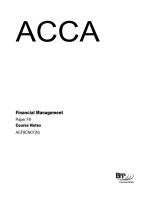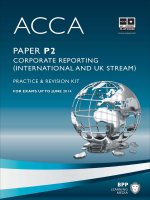ACCA 2016 BPP PASSCARD f3
Bạn đang xem bản rút gọn của tài liệu. Xem và tải ngay bản đầy đủ của tài liệu tại đây (2.91 MB, 161 trang )
ACCA APPROVED
CONTENT PROVIDER
FIA Passcards
FIA FFA / ACCA Paper F3
Financial Accounting
Passcards for exams from
1 September 2015 – 31 August 2016
FI32PC15.indd 1
23/03/2015 12:38
(000)FI32PC15_FP_ASH.qxp
3/10/2015
11:50 AM
Page i
FIA FFA
ACCA Paper F3
Financial Accounting
(000)FI32PC15_FP_RI.qxp
3/10/2015
11:52 AM
First edition 2011
Fourth edition March 2015
ISBN 9781 4727 3543 0
eISBN 9781 4727 2876 0
Page ii
All rights reserved. No part of this publication may be
reproduced, stored in a retrieval system or transmitted,
in any form or by any means, electronic, mechanical,
photocopying, recording or otherwise, without the prior
written permission of BPP Learning Media.
British Library Cataloguing-in-Publication Data
A catalogue record for this book is available from the
British Library
Published by
BPP Learning Media Ltd
BPP House, Aldine Place
142-144 Uxbridge Road
London W12 8AA
www.bpp.com/learningmedia
Printed in the United Kingdom by
RICOH UK Limited
Unit 2
Wells Place
Merstham RH1 3LG
Your learning materials, published by BPP Learning
Media Ltd, are printed on paper obtained from traceable
sustainable sources.
©
BPP Learning Media Ltd
2015
(000)FI32PC15_FP_ASH.qxp
3/10/2015
11:50 AM
Page iii
Preface
Contents
Welcome to BPP Learning Media's new FIA FFA/ACCA F3 Passcards.
They save you time. Important topics are summarised for you.
They incorporate diagrams to kick start your memory.
They follow the overall structure of BPP Learning Media's Interactive Texts, but BPP Learning Media's new
Passcards are not just a condensed book. Each card has been separately designed for clear presentation.
Topics are self contained and can be grasped visually.
Passcards are still just the right size for pockets, briefcases and bags.
Passcards focus on the exam you will be facing.
Run through the complete set of Passcards as often as you can during your final revision period. The day
before the exam, try to go through the Passcards again. You will then be well on your way to completing your
exam successfully.
Good luck!
Page iii
(000)FI32PC15_FP_ASH.qxp
3/10/2015
11:50 AM
Page iv
Preface
Contents
Page
1
Introduction to accounting
1
2
The regulatory framework
7
3
The qualitative characteristics of financial
information
11
4
Sources, records and books of prime
entry
19
5
Ledger accounts and double entry
25
6
From trial balance to financial
statements
33
Sales tax
41
7
8
Inventory
45
9
Tangible non-current assets
51
10
Intangible non-current assets
59
11
Accruals and prepayments
63
Page
12
13
Irrecoverable debts and allowances
Provisions and contingencies
67
71
14
Control accounts
75
15
Bank reconciliations
81
16
Correction of errors
85
17
Preparation of financial statements for
sole traders
91
18
Incomplete records
93
19
Introduction to company accounting
101
20
Preparation of financial statements for
companies
107
21
Events after the reporting period
113
22
Statements of cash flows
117
(000)FI32PC15_FP_ASH.qxp
3/10/2015
11:50 AM
Page
23
Introduction to consolidated financial
statements
123
24
The consolidated statement of financial
position
127
25
The consolidated statement of profit or
loss and other comprehensive income
133
26
Interpretation of financial statements
137
Page v
Page v
(000)FI32PC15_FP_ASH.qxp
3/10/2015
11:50 AM
Notes
Page vi
(001)FI32PC15_CH01.qxp
3/5/2015
1:08 AM
Page 1
1: Introduction to accounting
Topic List
This chapter looks at why financial statements are
prepared, the different types of business entities and the
users of financial statements.
The purpose of financial reporting
We also look at the main financial statements: the
statement of financial position and the statement of profit
or loss.
Types of business entity
Users
Governance
The main financial statements
(001)FI32PC15_CH01.qxp
The purpose of
financial reporting
3/5/2015
1:08 AM
Types of
business entity
Page 2
Users
Governance
The main
financial statements
The purpose of financial reporting
A business has a number of functions, the most
prominent is to make a profit for the owners
Profit is the excess of
income over expenditure
Financial
data
Books of
prime entry
Ledger
accounts
Trial
balance
Financial
statements
(001)FI32PC15_CH01.qxp
The purpose of
financial reporting
3/5/2015
1:08 AM
Types of
business entity
Page 3
Users
Governance
The main
financial statements
Types of business entity
Sole traders –Rrefers to ownership, sole traders can
have employees
Partnerships – Two or more people working together
to earn profits
Personally responsible
for debts of business
Limited liability company – Owners have liability
limited to the amount they
pay for their shares
– A limited liability company
has a separate legal
identity from its owners
Page 3
1: Introduction to accounting
(001)FI32PC15_CH01.qxp
3/5/2015
The purpose of
financial reporting
1:08 AM
Types of
business entity
Page 4
Users
Governance
The main
financial statements
Users of accounts
Managers of the company
Shareholders of the company
Trade contacts
The larger the entity, the greater
the interest from various groups
of people
Providers of finance to the company
Taxation authorities
Employees of the company
Financial analysts and advisors
Government and their agencies
The public
Different users have different
needs
(001)FI32PC15_CH01.qxp
3/5/2015
The purpose of
financial reporting
1:08 AM
Types of
business entity
Page 5
Users
Governance
The main
financial statements
Governance
Responsible for
preparation of
financial statements
Main aim:
to create wealth for
shareholders
Must act honestly in
best interests of
company
Page 5
Directors
Duty of care to
show reasonable
competence
Fiduciary
position
1: Introduction to accounting
(001)FI32PC15_CH01.qxp
The purpose of
financial reporting
3/5/2015
1:08 AM
Types of
business entity
Page 6
Users
Governance
The main
financial statements
Main financial statements
Statement of profit or loss
Statement of financial position
A list of assets owned by the
entity and liabilities owed by the
entity on a particular date
Total assets = Total liabilities
+ capital
Amount invested by owner
is capital
Asset
Something valuable which an
entity owns or has use of
Revenue
Income generated by a business
A record of income generated
and expenditure incurred over a
given period
Liability
Something owed to somebody
else
Expenses
Costs of running a business
(002)FI32PC15_CH02.qxp
3/5/2015
1:13 AM
Page 7
2: The regulatory framework
Topic List
The regulatory system
IASB
This is a look at the regulatory system and the role
played by the IASB.
(002)FI32PC15_CH02.qxp
3/5/2015
1:13 AM
Page 8
IASB
The regulatory
system
National law
Form and content of accounts
may be regulated by national
legislation. 'Fair presentation'.
Accounting
standards
Influences
upon
financial
accounting
The IASB produces standards.
Accounting concepts and
individual judgement
Can lead to subjectivity.
Accounting standards developed
to address subjectivity.
Other international
issues
GAAP
Drawn from:
Local company law
Accounting standards
Statutory requirement in other
countries
Stock exchanges
(002)FI32PC15_CH02.qxp
3/5/2015
1:13 AM
Page 9
The regulatory
system
IASB
Monitoring Board
IFRS Foundation
IFRS Advisory Council
IASB
Appoints
Reports to
Advises
Page 9
IFRS Interpretations
Committee (IFRIC)
2: The regulatory framework
(002)FI32PC15_CH02.qxp
3/5/2015
1:13 AM
Page 10
The regulatory
system
IASB
Objectives of IFRS Foundation are to:
1) Develop a single set of high quality, understandable, enforceable and globably accepted IFRSs through
standard-setting body IASB
2) Promote use and rigorous application of these standards
3) Take account of the needs of emerging economies and SMEs
4) Bring about convergence of national accounting standards and IFRSs to high quality solutions
(003)FI32PC15_CH03.qxp
3/5/2015
2:22 AM
Page 11
3: The qualitative characteristics of financial
information
Topic List
Modern accounting is based on certain concepts and
conventions.
The IASB's Conceptual Framework
Get to grips with these and you should be well equipped
to discuss accounting standards and their strengths and
weaknesses.
(003)FI32PC15_CH03.qxp
3/5/2015
2:22 AM
Page 12
The IASB's Conceptual
Framework
Underlying Assumption
Going concern
The entity will continue in
operation for the foreseeable
future. There is no intention to
put the entity into liquidation
Accruals
Revenue and costs must be
recognised as they are earned
or incurred, not as money is
received or paid
Not an underlying assumption but
accounts should be prepared on
an accruals or matching basis
(003)FI32PC15_CH03.qxp
3/5/2015
2:22 AM
Page 13
Qualitative characteristics
Conceptual Framework
Qualitative characteristics make
info in financial statements
useful to users
Two fundamental characteristics
Relevance
Faithful representation
Page 13
3: The qualitative characteristics of financial information
(003)FI32PC15_CH03.qxp
3/5/2015
2:22 AM
Page 14
The IASB's Conceptual
Framework
Relevance
– Info is relevant when it influences decisions of users,
affected by nature and materiality
Materiality
Info is material if its omission or misstatement could
influence the economic decisions of users taken on the
basis of the financial statements
Faithful representation
– Financial information must faithfully represent
the underlying economic phenomena
– Complete, neutral, free from error
(003)FI32PC15_CH03.qxp
3/5/2015
2:22 AM
Page 15
Enhancing characteristics:
comparability; verifiability; timeliness; understandability
must be able to compare financial statements
Comparability – Users
through time and with other entities
– Disclose accounting policies
– Disclose corresponding info for comparative periods
Page 15
Verifiability
– Information that can be independently verified
Timeliness
– Information is available in time to be capable of
influencing decisions
3: The qualitative characteristics of financial information
(003)FI32PC15_CH03.qxp
3/5/2015
2:22 AM
Page 16
The IASB's Conceptual
Framework
Understandability
– Users must be able to understand financial statements
– Users assumed to have some economic, business and
accounting knowledge
– Complex matters should not be left out if relevant
Reliability
Info is reliable when it is free from material error and bias and can be depended
upon to represent faithfully what it either purports to represent or could reasonably
be expected to represent.
(003)FI32PC15_CH03.qxp
3/5/2015
2:22 AM
Page 17
Other concepts
Business entity
concept
In accounting, the
business is treated as
separate to its owners.
Not the same as limited
liability!
Page 17
Fair presentation
Financial statements are
required to present fairly
in all material respects
the financial results and
position of the business.
Consistency
Presentation and
classification of items
should remain consistent
from one period to the
next.
Compliance with IFRSs
will achieve this.
3: The qualitative characteristics of financial information
(003)FI32PC15_CH03.qxp
3/5/2015
2:22 AM
Page 18
Notes









